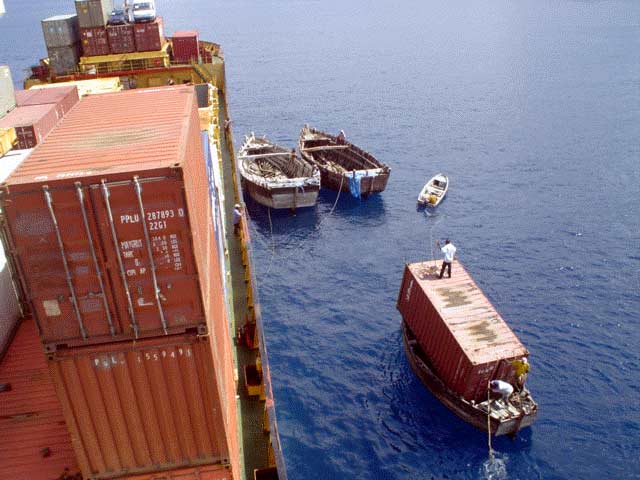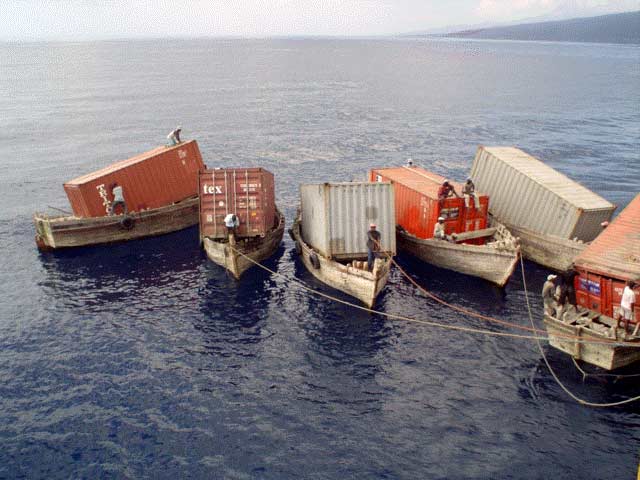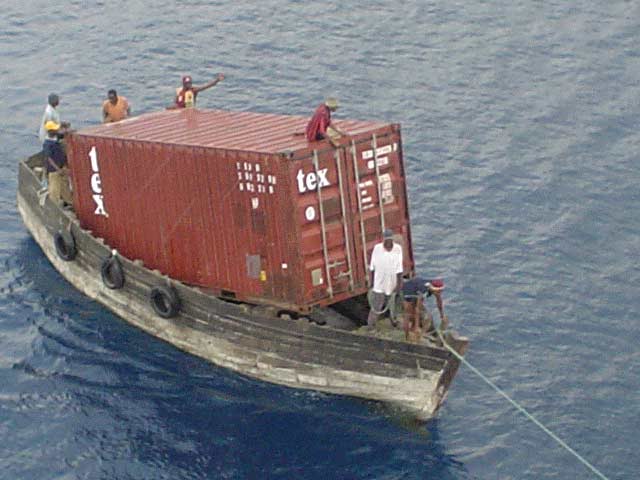Personal Container Management
Designers have had a fascination with everything modular since the beginnings of modernism. That fascination runs from awe at the sublime machinations of contemporary shipping container ports with their amazing cranes and almost unreal scale, to the use of shipping containers in an enormous variety of architectural projects as housing, structure and works of art (see 50 selected projects utilizing shipping containers at fabprefab.com)
But there’s another side to shipping containers – a polar opposite of the inhuman scale and automation of massive port operations that reduce people to no more than ants. These photos from the 1980’s were taken before container shipping facilities were available in the tiny island nation of the Comoros in the ocean between Madagascar and Mozambique off the east coast of Africa. The containers are amazingly being lifted aboard small wooden boats just big enough for one each – with workers crawling all over them decidedly larger than ant-size.
You could be forgiven for thinking these are clever examples of Photoshop par excellence – but they’re not. They were published in the Nautical Institute’s “Seaways” magazine in January 2006 with the following caption:
“‘These remarkable photos were taken in the 1980s, when a liner company called Unicom operated a service to Moroni, Comoros Islands. At the time, this was the only means of getting the containers ashore.”
While it seems unlikely that the same situation exists anywhere today, it is wondrous and scary to think about how the way we move goods has fundamentally changed in the last 20 years or so as trade liberalization has come to dominate international economics. This almost comic situation represents a calamitous meeting of old economy and new – these men, stevedores (or longshoremen or dockers) in the true old sense, are perhaps using the same method and means as was traditionally used to move cargoes bit by bit from large ships too big to moor next to dock. Instead of more of a pile of looser smaller goods, the little boats have simply accommodated a singe container each.
I don’t mean to be some kind of neo-luddite, but the sheer humanity of these scenes put a huge smile on my face. Unfortunately, the Comoros is still one of the poorest countries in the world, so it’s no laughing matter – but there is something uplifting and wonderful about the ways that poor people with meagre resources manage to get by and get things done through sheer determination and hard work.
So cheers to the enterprising stevedores of the Comoros – wherever they may be now. To paraphrase The Road Warrior (aka Mad Max 2), this type of thing more and more “lives now, only in our memories”.
Photos originally found via www.cargolaw.com




5 Comments so far
Leave a comment
UPDATE***
I discovered this related comment from March 2006 on A Welsh View:
Andrew commented: “I just returned from living in the Comoros, near Moroni. And twenty years later this has not changed at all. This is still how they unload. I’ve witnessed instances during heavy windstorms some of these get away and go for miles with the containers on them before they can be caught.”
http://xo.typepad.com/blog/2006/03/container_on_bo.html
Amazing.
However, I then discovered the following news item from September 2006 which indicates that the practice is finally going to come to an end – it’s saddening how it seems almost by being able to find out about such things, it suggests they are hastening towards their demise:
“Emirates-based Gulftainer has been awarded the concession to operate and manage the ports of Moroni and Mutsamudu in the Comoros for a period of 15 years… the UAE company will begin upgrading and expanding the islands’ ports with new infrastructure to improve cargo handling, increase the cargo storage areas and provide new warehouse areas… Gulftainer’s GM Peter Ricjhards said the main aim in the Comoros was to drastically reduce the time that vessels take to discharge and load their cargo in the port of Moroni. He said this would allow the consignees and shippers of the Comoros Islands to negotiate better freight rates from the shipping lines, and in turn reduce the cost of doing business in the Comoros.”
Ports & Ships Maritime News
http://www.ports.co.za/news/article_2006_09_14_2004.html
Sad in some ways – but I’m sure better for the Comoros in the long run – it’s really questionnable how beneficial isolation is in these times, regardless of how much we might romantacise it.
-RC
By Editor on 11.23.06 9:45 pm
[…] […]
By myninjaplease » Blog Archive » Foto del dia 11.28 on 11.28.06 8:52 am
[…] where this idea is headed… for something mildly related, don’t forget to check out the Personal Container Management post from November, and to see 50 selected projects utilizing shipping containers try […]
By Bricoleurbanism » Favela Japonesa on 03.15.07 4:36 pm
[…] blogginlägget Personal Container Management […]
By Vad innehåller en container? « Älvida – Älvens Ida on 09.28.10 4:00 am
Container and small wooden boat is no longer an option.
By Interesting Foto on 05.09.11 5:30 am
Leave a comment
Line and paragraph breaks automatic, e-mail address never displayed, HTML allowed:
<a href="" title=""> <abbr title=""> <acronym title=""> <b> <blockquote cite=""> <cite> <code> <del datetime=""> <em> <i> <q cite=""> <s> <strike> <strong>